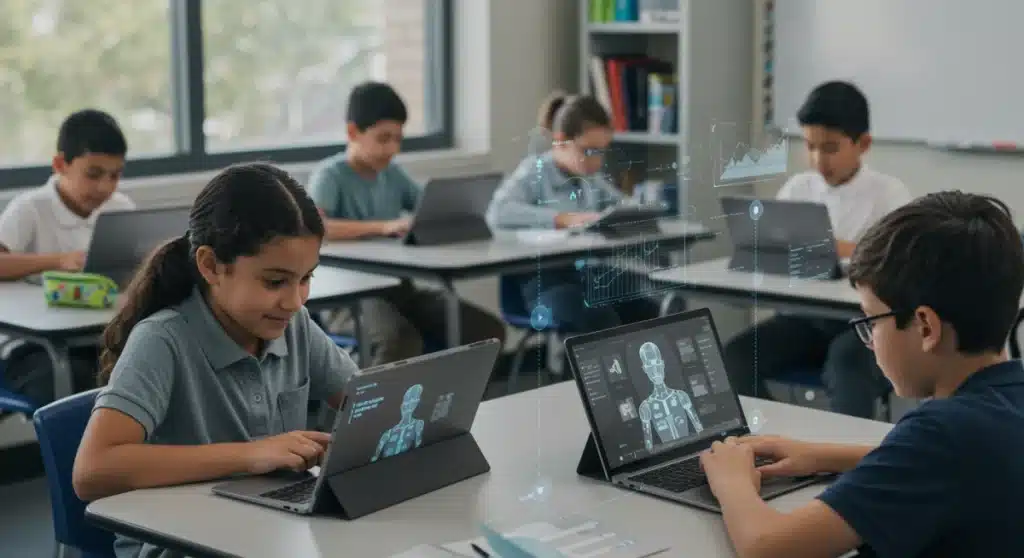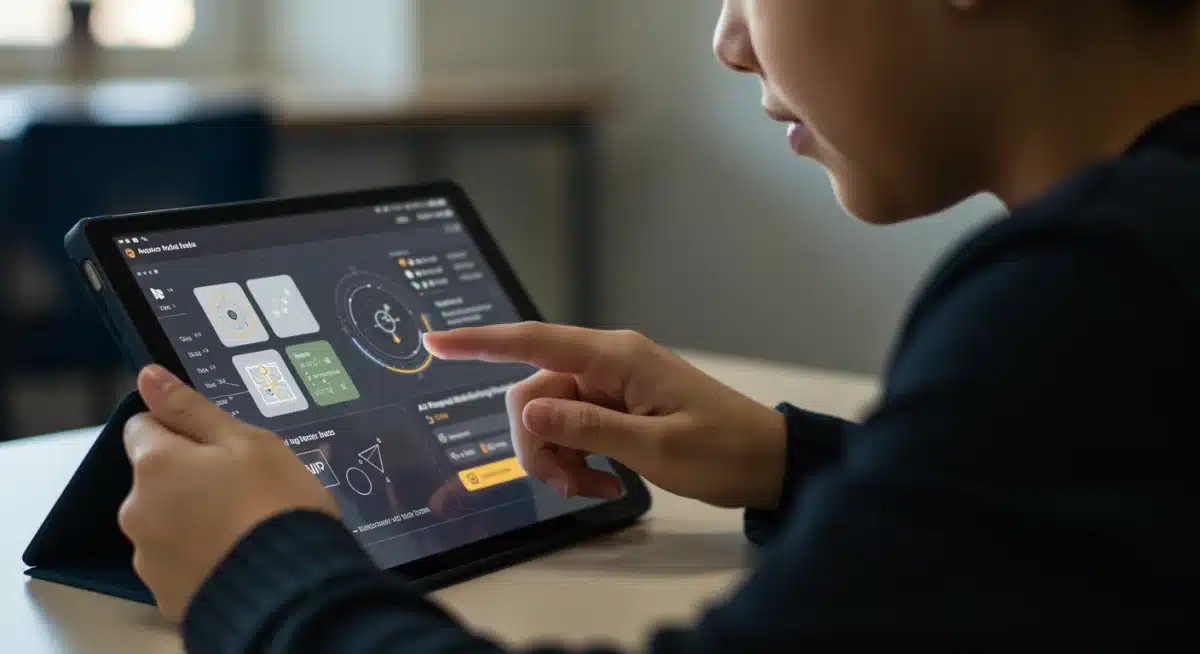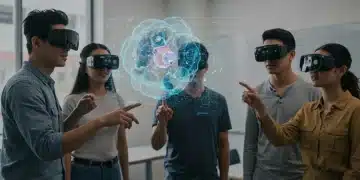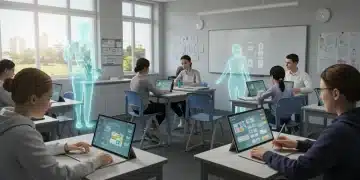AI-Powered Tutoring Systems: K-12 Transformation by 2025

The landscape of K-12 education is on the cusp of a profound transformation. By 2025, the integration of AI-Powered Tutoring Systems is expected to fundamentally reshape how students learn, offering a practical solution for truly personalized education.
The Rise of AI in K-12 Learning
Artificial intelligence is no longer a futuristic concept but a rapidly evolving reality within educational settings. Its application in K-12 is particularly promising, moving beyond simple automation to intelligent systems that can adapt to individual student needs. This shift is driven by the increasing demand for personalized learning experiences that traditional classroom models often struggle to provide.
As of late 2024, pilot programs across several districts indicate significant advancements in AI’s capability to deliver tailored instruction. These systems leverage sophisticated algorithms to analyze student performance, identify learning gaps, and offer targeted interventions, promising a more equitable and effective educational journey for all.
Understanding Adaptive Learning Technologies
Adaptive learning technologies form the core of AI-powered tutoring systems. These platforms continuously assess a student’s knowledge and skill level, dynamically adjusting the curriculum and teaching methods in real-time. This ensures that content is neither too easy nor too challenging, maintaining optimal engagement and promoting deeper understanding.
- Personalized Pace: Students progress at their own speed, mastering concepts before moving on.
- Customized Content: Learning materials are adapted to individual learning styles and preferences.
- Immediate Feedback: Students receive instant feedback on their work, correcting misconceptions promptly.
- Targeted Interventions: AI identifies specific areas of struggle and provides focused support.
Personalized Learning Pathways: A New Reality
The promise of personalized learning has long been a goal in education. With AI-powered tutoring systems, this aspiration is becoming a tangible reality. These systems are designed to create unique educational journeys for each student, catering to their strengths, weaknesses, and preferred learning styles.
This individualized approach ensures that every student receives the support they need to succeed, moving away from the one-size-fits-all model that has historically dominated K-12 education. The data collected by these systems also provides invaluable insights for teachers, allowing them to better understand their students’ progress and areas of difficulty.
How AI Tailors Education
AI algorithms analyze vast amounts of data, including student responses, time spent on tasks, and patterns of errors. This analysis informs the system’s decisions on what content to present next, what type of explanations to offer, and when to recommend additional practice. The goal is to optimize the learning experience for maximum retention and comprehension.
For instance, if a student consistently struggles with algebraic equations, the AI tutor can introduce supplementary lessons, provide interactive examples, or even suggest alternative approaches to the problem. This level of responsiveness is unprecedented in traditional educational settings.
Enhancing Teacher Effectiveness with AI Tools
Contrary to concerns about AI replacing human educators, AI-powered tutoring systems are emerging as powerful tools that enhance teacher effectiveness. By automating many of the routine tasks associated with personalized instruction, AI frees up teachers to focus on higher-level activities like mentorship, critical thinking development, and addressing complex emotional or social needs.
Teachers gain access to granular data on student performance, allowing them to pinpoint areas where individual students or the class as a whole might need more attention. This data-driven approach empowers educators to make more informed decisions and tailor their in-class instruction more effectively.
Streamlining Administrative and Pedagogical Tasks
AI systems can significantly reduce the administrative burden on teachers. Tasks such as grading quizzes, tracking progress, and generating reports can be automated, allowing teachers more time for direct student interaction and professional development. This efficiency directly contributes to a more productive and engaging learning environment.
- Automated Assessment: AI handles grading of objective questions, providing instant feedback.
- Progress Monitoring: Detailed reports on student performance are generated automatically.
- Resource Curation: AI suggests relevant learning resources based on student needs.
- Differentiated Instruction Support: Teachers receive recommendations for adapting lessons.

Addressing Learning Gaps and Equity
One of the most significant challenges in K-12 education is addressing the diverse learning needs within a single classroom. Students often enter school with varying levels of foundational knowledge, leading to significant learning gaps that can widen over time. AI-powered tutoring systems offer a robust solution to this persistent problem, promoting greater educational equity.
By providing individualized support, these systems can help close these gaps by offering targeted remediation and acceleration. This means students who are falling behind can catch up at their own pace, while advanced learners can be challenged with more complex material, ensuring no student is left behind or held back.
Equitable Access to High-Quality Instruction
AI tutors can democratize access to high-quality, personalized instruction, regardless of a student’s socioeconomic background or geographic location. In areas where access to skilled human tutors is limited or cost-prohibitive, AI provides a scalable and affordable alternative. This fosters a more equitable educational landscape where every student has the opportunity to receive tailored support.
The systems can also be particularly beneficial for students with special educational needs, offering consistent, patient, and infinitely adaptable support that can be difficult to achieve in a traditional classroom setting. This adaptability is key to fostering inclusivity in education.
Challenges and Considerations for Implementation
While the potential of AI-powered tutoring systems is immense, their widespread implementation by 2025 faces several challenges and requires careful consideration. Issues such as data privacy, algorithmic bias, and the need for adequate teacher training are critical factors that must be addressed for successful integration into K-12 education.
Ensuring that these systems are developed and deployed ethically and responsibly is paramount. Stakeholders, including educators, policymakers, parents, and students, must collaborate to establish guidelines and best practices that maximize the benefits while mitigating potential risks.
Navigating Data Privacy and Security
The collection of student data is central to the effectiveness of AI tutoring systems. However, this raises significant concerns about privacy and security. Robust protocols must be in place to protect sensitive student information from breaches and misuse. Transparent data handling policies and compliance with regulations like FERPA are essential.
- Data Anonymization: Implementing techniques to protect student identities.
- Secure Storage: Utilizing encrypted servers and secure cloud solutions.
- Consent and Transparency: Clearly communicating data usage to parents and students.
- Regular Audits: Conducting frequent security checks to identify vulnerabilities.
The Future Outlook: AI in K-12 by 2025
Looking ahead to 2025, the integration of AI-powered tutoring systems into K-12 education is expected to be widespread and transformative. These systems will not only personalize learning but also evolve to become more sophisticated, incorporating advanced features like emotional intelligence and predictive analytics to further enhance student outcomes.
The initial phase will likely see hybrid models, where AI tools complement human teachers, rather than fully replacing them. This collaborative approach leverages the strengths of both AI’s analytical capabilities and human educators’ empathetic guidance, creating a powerful synergy for student development.
Evolving Capabilities of AI Tutors
Future iterations of AI tutors are anticipated to move beyond cognitive support, potentially offering socio-emotional learning modules. They could help students develop resilience, problem-solving skills, and even social cues by analyzing their interactions and responses. This holistic approach to education aims to prepare students not just academically, but for life.
Furthermore, the continuous feedback loop between AI systems and educational researchers will drive rapid improvements, making these tools increasingly effective and responsive to the dynamic needs of K-12 learners. The goal is to foster a generation of self-directed, confident, and capable individuals.
| Key Point | Brief Description |
|---|---|
| Personalized Learning | AI tailors educational content and pace to individual student needs and learning styles. |
| Teacher Empowerment | AI tools automate tasks, providing data insights that enhance teacher effectiveness and focus. |
| Equity and Access | AI tutors help bridge learning gaps and provide high-quality instruction to all students. |
| Implementation Challenges | Addressing data privacy, algorithmic bias, and teacher training is crucial for success. |
Frequently Asked Questions About AI Tutoring
AI systems analyze student performance data, identify strengths and weaknesses, and then dynamically adapt content, pace, and teaching methods to create a unique learning path for each individual, ensuring optimal engagement and comprehension.
No, AI tutors are designed to augment, not replace, human teachers. They automate routine tasks and provide data-driven insights, allowing educators to focus more on complex pedagogical challenges, mentorship, and socio-emotional development, fostering a collaborative learning environment.
Students benefit from personalized instruction, immediate feedback, tailored content, and the ability to learn at their own pace. This helps close learning gaps, boosts confidence, and provides access to high-quality educational resources, leading to improved academic outcomes.
Primary challenges include ensuring student data privacy and security, addressing potential algorithmic biases, providing adequate training for teachers, and ensuring equitable access across all schools. Ethical development and responsible deployment are crucial for success.
By 2025, AI tutoring systems are expected to be more sophisticated, incorporating emotional intelligence and predictive analytics. They will likely support hybrid learning models, collaborating with human teachers to offer comprehensive academic and socio-emotional development for students.
What This Means
The rapid advancement and integration of AI-powered tutoring systems into K-12 education represent a pivotal shift. This means a future where learning is inherently more adaptive, equitable, and efficient for every student. Educators and institutions must now prioritize strategic planning for adoption, focusing on robust data governance and comprehensive professional development for teachers. The coming months are critical for establishing the frameworks that will define this new era of personalized learning, ensuring technology serves to amplify human potential in education.





